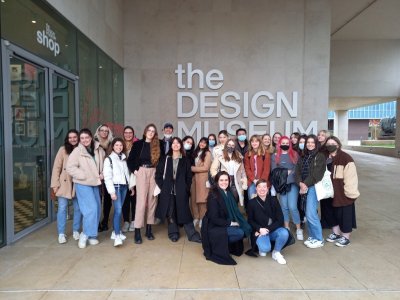Media fieldtrip to design museum: Thinking about media and the environment
On 9 February a group of BSc Media and Communications students went to the Design Museum London along with Nathalie Weidhase, Robyn Muir and Tom Roberts to visit their temporary exhibition 'Waste Age: What Can Design Do?', and their permanent display 'Designer Maker User'.

The trip was a great opportunity to think about the ways in which engagement with media objects has evolved over time, and how digital media technologies contribute to the problem of e-waste on the one hand, but can also help find possible solutions in the future on the other. This offered students the opportunity to see their theoretical knowledge of media and communication come to life outside of the classroom.
Or first stop, then, was the temporary exhibition ‘Waste Age: What Can Design Do?’, which explores the link between design, waste, and sustainability. E-waste is the waste produced by technology products, the same products we use to consume and produce media, and the UK is currently one of the biggest producers of e-waste in the world. Your old iPhone, left on the metaphorical and physical dung heap when it got replaced by the latest model, is an ever-increasing presence in landfill. With our consumption habits unlikely to change in the immediate future, this poses significant challenges, both practical and ethical. As Media and Communication students, the ways in which our media consumption contributes to the pollution of the planet is of great concern and a topic that regularly comes up in class discussions.
In the exhibition then, our students explored the history of conventional forms of rubbish such as plastic, and how its use evolved throughout history. The exhibition also highlighted the global scale of the problem: Ibrahim Mahama’s e-waste served as a reminder of the distances discarded electronics travel. Old TV monitors used in the installation show clips from Agbogbloshie in Ghana, one of the world’s largest e-dumps, where the West’s discarded smartphones and laptops end up. Here, workers harvest copper wire and other precious materials from discarded electronics. But there are sign of progress and possible solutions: global online communities like repair platform iFixit publish free repair guides to prolong the lives of our tech devices.
Finally, the exhibition gave us space to reflect on our contemporary circumstances. Second year student Syazwan contextualised the exhibition with his experience of the pandemic and our reliance on single use products to keep others and ourselves safe, saying “It was very insightful to see the modern approaches as to how waste is managed and recreated throughout history, especially with the covid-19 virus playing an important factor.”
I thought it was a really good opportunity to go to a real place and learn about how our degree relates to the wider world - and it was also really fun to interact with others in the course outside of a university environment [which showcase] areas where media and communications is relevant to the workplace/society
Rosie, second year BSc Media and CommunicationThe permanent exhibition ‘Designer Maker User’ walks the visitor through some key design moments in the 20th and 21st century, from fashion to transport to technology. But it also works as a short lesson in media history. Take, for example, the way in which we listen to music on the go. In the exhibition, we were able to follow the evolution of portable music listening devices from the Walkman to the Discman, and finally to the now chunky-looking iPods, which of course have been discarded for phones, which now double up as communication devices and media consumption platforms. (Many of these items would of course not end up in this exhibition space, but as e-waste somewhere in a landfill.)
The exhibition also features what Media and Communication lecturer Robyn Muir called ‘the wall of convergence’. This wall showcases what media scholar Henry Jenkins defines as convergence: “the flow of content across multiple media platforms, the cooperation between multiple media industries, and the migratory behaviour of media audiences who will go almost everywhere in search of the kinds of entertainment experiences they want” (Jenkins, 2008: 2-3)
Students are of course familiar with Jenkins' work, and have explored the evolution of media devices, and how they shape our consumption of media texts and products, through their discussions of media convergence on a range of modules on the degree. The exhibition offered an opportunity to explore this knowledge outside of the classroom, and contextualise it not only within the history of design and media, but broader trends as well.
As second year student Rosie highlighted, “I thought it was a really good opportunity to go to a 'real' place and learn about how our degree relates to the wider world- and it was also really fun to interact with others in the course outside of a university environment [which showcase] areas where media and communications is relevant to the workplace/society.“